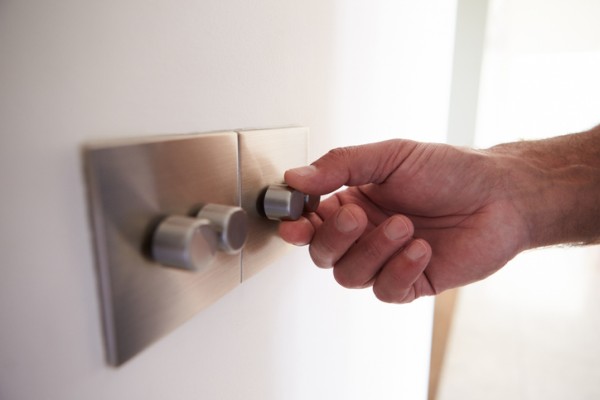
A dimmer is a switch that lets you vary the brightness of your lights, usually by turning a knob, sliding a lever or tapping a button. Instead of a basic on/off toggle, a dimmer adjusts how much electricity reaches the light, allowing you to set the level of illumination.
Dimmers can:
- Create a more comfortable atmosphere
- Extend the life of your light globes
- Reduce your energy consumption
- Offer greater control and flexibility in multi-use rooms
You’ll commonly find them in living areas, dining rooms, bedrooms, home theatres and even bathrooms — anywhere you want light that can shift with your mood or task.
Types of dimmers
There are several types of dimmers available in Australia, each suited to different lighting systems and globes.
Rotary dimmers
These are the classic knob-style dimmers. You twist to increase or decrease brightness. Some models push to switch the light on or off.
Slide dimmers
A linear version of the rotary dimmer, these use a sliding switch for brightness control — great for precision and simple to use.
Touch dimmers
Often used with modern fittings, these allow dimming through a touch-sensitive plate. Some feature memory functions or adjustable fade times.
Remote-control dimmers
Operated by a handheld remote or smartphone app, these offer wireless control. Perfect for bedrooms or living rooms where convenience matters.
Smart dimmers
Integrated into a home automation system, smart dimmers can be scheduled, voice-controlled or operated remotely via WiFi. Ideal for energy-conscious homeowners who want complete control over their lighting.
Choosing the right dimmer for your globes
Not all globes can be dimmed — and not all dimmers are compatible with every type. Choosing the wrong combination can cause flickering, buzzing or outright failure.
Here’s how different lighting types interact with dimmers:
| Globe type | Dimmable? | Notes |
|---|---|---|
| Incandescent | Yes | Works well with most dimmers |
| Halogen | Yes | Dimmable, but can run hot |
| CFL | Only if labelled dimmable | Needs a compatible dimmer |
| LED | Only if labelled dimmable | Requires an LED-compatible dimmer |
Tip: If you’re using LED lighting, always check that both the globe and the dimmer are designed to work together. Many modern LED dimmers are “trailing edge” models, which work better with low-wattage LEDs than older “leading edge” dimmers.
Where dimmers work best
Dimmers can enhance both function and atmosphere when used strategically throughout the home.
- Living rooms: Create a cosy movie night vibe or brighten the room for entertaining.
- Bedrooms: Lower lighting for winding down at night, or raise it for reading.
- Dining areas: Set the mood for dinner or increase brightness for working or entertaining.
- Bathrooms: Dim light for relaxing baths while keeping brighter settings for shaving or makeup.
- Kitchens: Use with island pendants or accent lighting — but keep task lights (like under-cabinet LEDs) at full brightness for safety.
Energy efficiency and safety
Dimming your lights not only improves comfort, it also saves energy — particularly if you’re using halogen or LED lighting. Lower brightness means lower power consumption, which adds up over time.
However, dimmers themselves must be safely installed by a licensed electrician. Installation involves modifying your home’s electrical system, so DIY is not an option.
Also:
- Avoid using dimmers with non-dimmable globes
- Don’t exceed the wattage rating of the dimmer
- If you hear buzzing or see flickering, have the setup checked
Smart home integration
If you’re investing in home automation, dimmers can be linked to your smart system. This allows you to:
- Control lighting remotely via smartphone
- Set schedules or scenes (e.g. “morning,” “movie night”)
- Pair lights with other smart devices like sensors or voice assistants
Some smart dimmers can even track energy use, helping you reduce your consumption and identify patterns over time.
The bottom line
Dimmers give you control over brightness, comfort and efficiency — whether you want soft ambient light or full brightness for a task. Just make sure your lights and dimmers are compatible, and always use a qualified electrician for installation.





